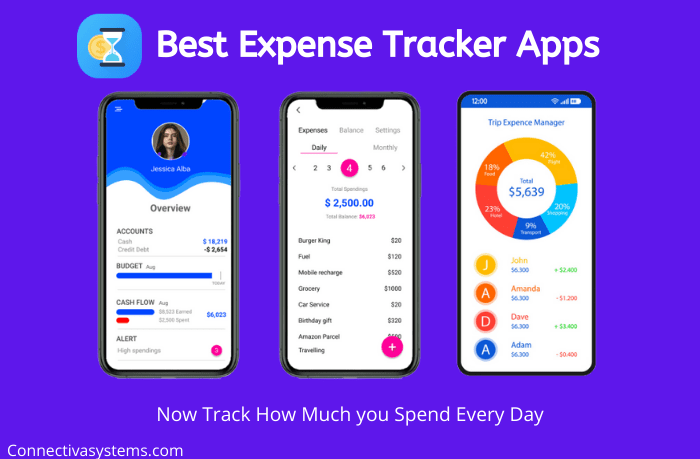Diving into the world of expense tracking apps opens up a whole new realm of possibilities for managing your finances with ease and precision. Get ready to explore the top features, popular apps, and expert tips that will revolutionize the way you handle your expenses. It’s time to take control of your money like a boss!
Benefits of Expense Tracking Apps
Expense tracking apps offer a range of advantages for individuals looking to manage their personal finances more effectively. These apps can help users save money, streamline the process of recording expenses, and create budgets with ease.
Real-time Expense Monitoring
Expense tracking apps allow users to monitor their spending in real-time, providing instant visibility into where their money is going. This helps individuals identify areas where they may be overspending and make necessary adjustments to their budget.
Automated Expense Categorization
These apps automatically categorize expenses, making it easier for users to see how much they are spending in different areas such as groceries, entertainment, or bills. This categorization helps users understand their spending patterns and make informed decisions about where to cut back.
Budget Creation and Tracking
Expense tracking apps make it simple to set up budgets and track progress towards financial goals. Users can easily see if they are staying within budget for each spending category, allowing them to adjust their habits as needed to meet their financial objectives.
Receipt Scanning and Expense Reports
Many expense tracking apps offer features such as receipt scanning and expense report generation, saving users time and hassle when it comes to organizing financial documents. These tools make tax season easier and ensure that users have a clear record of their spending.
Features to Look for in Expense Tracking Apps
When choosing an expense tracking app, it is crucial to consider the features that will best suit your financial needs. Here are some essential features to look for in a good expense tracking app:
Categorization of Expenses
- Ability to categorize expenses into different groups such as food, transportation, utilities, etc.
- Customizable categories to match your spending habits and preferences.
- Automatic categorization based on transaction data for convenience.
Reporting Capabilities
- Generate detailed reports on your spending patterns, trends, and habits.
- Visual representation of data through charts, graphs, and tables for easy understanding.
- Export reports in various formats like PDF or CSV for further analysis or sharing.
Budget Goal Setting
- Set monthly, weekly, or custom budget goals to track and control your spending.
- Receive notifications and alerts when approaching or exceeding budget limits.
- Ability to adjust budget goals based on changing financial circumstances.
Synchronization with Bank Accounts and Credit Cards
- Secure connection to your bank accounts and credit cards for real-time tracking of transactions.
- Automatic updates of expenses and income to ensure accurate financial overview.
- Reconciliation of transactions to avoid missing or duplicate entries.
Popular Expense Tracking Apps
Expense tracking apps have become essential tools for managing personal finances efficiently. Here are some of the most popular expense tracking apps available in the market today.
1. Mint
Mint is a free expense tracking app that allows users to link their bank accounts, credit cards, and investments to get a comprehensive view of their financial health. It categorizes expenses, creates budgets, and provides personalized money-saving tips.
2. Expensify
Expensify offers both free and subscription-based plans for individuals and businesses. It simplifies expense reporting by scanning receipts, tracking mileage, and automating expense approvals. Users can also integrate Expensify with accounting software like QuickBooks.
3. PocketGuard
PocketGuard is a freemium expense tracking app that helps users track their spending, manage bills, and create savings goals. It provides insights into cash flow, alerts for overspending, and helps optimize recurring expenses.
4. YNAB (You Need a Budget)
YNAB is a subscription-based expense tracking app focused on budgeting and financial planning. It uses a zero-based budgeting approach, encourages users to give every dollar a job, and offers educational resources to help users achieve financial goals.
5. Wally
Wally is a free expense tracking app that offers a simple and intuitive interface for tracking expenses, setting savings goals, and monitoring spending habits. It does not require users to link their bank accounts, making it a more privacy-focused option.
Tips for Using Expense Tracking Apps Effectively
![]()
When it comes to making the most out of expense tracking apps, there are some key strategies that can help you stay on top of your finances and reach your financial goals.
Setting Realistic Budgets and Financial Goals
- Start by assessing your current financial situation and determining your income and expenses.
- Set realistic budget limits for different categories such as groceries, entertainment, and transportation.
- Establish clear financial goals such as saving for a vacation or paying off debt, and track your progress regularly.
- Use the app’s budgeting tools to monitor your spending and adjust your budget as needed.
Analyzing Spending Patterns and Making Adjustments
- Regularly review your spending patterns to identify areas where you may be overspending.
- Look for trends in your expenses and adjust your budget accordingly to align with your financial goals.
- Use the app’s reporting features to generate insights into your spending habits and make informed decisions.
- Consider using alerts and notifications to stay updated on your budget status and avoid overspending.

